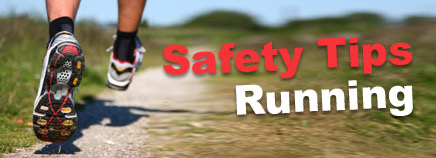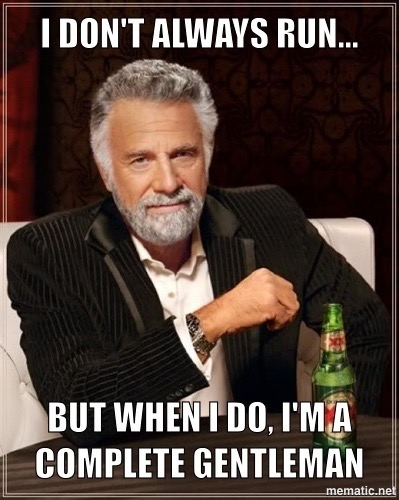Safety
(Excerpt from Road Runners Club of America)

- DON’T WEAR HEADPHONES*. Use your ears to be aware of your surroundings. Your ears may help you avoid dangers your eyes may miss during evening or early morning runs.
* If you absolutely need your music, purchase headphones which are designed to allow you to hear ambient noise in order to remain aware of potential dangers. - Run against traffic so you can observe approaching automobiles. By facing on-coming traffic, you may be able to react quicker than if it is behind you.
- Stop at stop signs and look both ways before crossing. Be sure the driver of a car acknowledges your right-of-way before crossing in front of a vehicle. Obey traffic signals.
- Be alert on blind curves.
- Carry identification or write your name, phone number, and blood type on the inside sole of your running shoe. Include any medical information.
- Always stay alert and aware of what’s going on around you. The more aware you are, the less vulnerable you are.
- Carry a cell phone or change for a phone call. Know the locations of public phones along your regular route.
- Trust your intuition about a person or an area. React on your intuition and avoid a person or situation if you’re unsure. If something tells you a situation is not “right”, it isn’t.
- Alter or vary your running route pattern; run in familiar areas if possible. In unfamiliar areas, such as while traveling, contact a local RRCA club or running store. Know where open businesses or stores are located in case of emergency.
- Run with a partner. Run with a dog.
- Write down or leave word of the direction of your run. Tell friends and family of your favorite running routes.
- Avoid unpopulated areas, deserted streets, and overgrown trails. Avoid unlit areas, especially at night. Run clear of parked cars or bushes.
- Ignore verbal harassment and do not verbally harass others. Use discretion in acknowledging strangers. Look directly at others and be observant, but keep your distance and keep moving.
- Wear reflective material if you must run before dawn or after dark. Avoid running on the street when it is dark.
- Practice memorizing license tags or identifying characteristics of strangers.
- Carry a noisemaker. Get training in self-defense.
- When using multi-use trails, follow the rules of the road. If you alter your direction, look over your should before crossing the trail to avoid a potential collision with an oncoming cyclist or passing runner.
- CALL POLICE IMMEDIATELY if something happens to you or someone else, or you notice anyone out of the ordinary. It is important to report incidents immediately
General Running Civility
(Excerpt from Road Runners Club of America)

- Never run more than two abreast if you are running in a group. Don’t be a road or trail hog.
- Don’t run down the middle of the road or trail.
- When running an out-and-back route, don’t make a sudden u-turn at your turn around point. Stop, step to the right to allow oncoming traffic the opportunity to pass. Ensure the road or trail is clear of oncoming traffic (runners, cyclists, in-line skaters, etc.) then make your u-turn. Making a sudden u-turn without looking over your shoulder is a good way to get hit.
- Alert pedestrians when passing them – don’t assume they are aware of their surroundings. A simple “on your left” warning will suffice.
- Respect private property along your route. Don’t relieve yourself in the neighbor’s bushes.
- Don’t litter. If you can’t find a trash can, carry your trash home.
Running in an Event
- FOLLOW THE RULES OF THE RACE OUTLINED ON THE RACE ENTRY FORM! All runners have a collective responsibility to keep the event safe. Races generally discourage running with dogs, headphones, cell phones, and jogging strollers.
- Pre-register even if same day registration is offered. This will help ease the registration process for everyone involved.
- Arrive early for the event, especially if you are picking up your number on race day. Check your registration information carefully, especially if you are racing for an award or prize money.
- Use the facilities before the race start to lessen the need once on course, and help keep the facilities clean for person in line after you.
- Pin your race number on the front of your shirt/shorts. This is where it is most visible for photographers and race officials.
- Line up according to how fast you plan to run or walk the event. Slower runners and walkers should move to the back of the race pack. Just because you arrived early does not mean you should be at the front of the starting line.
- Pay attention to the pre-race instructions. This is NOT the time to be blaring your favorite song on your personal music device (which should be locked in your car or at home).
Race Etiquette on Course
- If you drop something as the race starts, don’t stop and pick it up! Wait until almost everyone has crossed the starting line; then retrieve it.
- Don’t drop clothing on the course after you warm-up. If you must shed layers of clothing, tie them around your waist or place them on the side of the road where no one will trip over them. If you drop it; don’t expect to get it back.
- Run or walk no more than two abreast.
- Do not block runners coming up behind you by swerving needlessly back and forth across the course.
- If you are walking in a group, stay to the back of the pack and follow the two abreast rule.
- Bodily functions are a fact of life during a race. If you need to spit, blow your nose or throw-up, move to the side of the road and do it there. If nature calls, check for a port-a-potty, an open business, a kind neighbor along the course, or as a last resort, a discreet clump of bushes before relieving yourself.
- Move to the side if someone behind you says “excuse me” or “on you’re your right/left”. The person behind you is giving you a heads up before passing. It’s proper race etiquette to let that person pass you without blocking their effort.
- If someone in front of you is wearing headphones, and they are blocking, gently touch their elbow or shoulder as you pass to alert them to your presence.
- If you need to tie your shoe or stop for any reason (phone call, nose blow, etc) move to the side of the road and step off the course.
- Pay attention to your surroundings. The course may or may not be closed to traffic. It is your responsibility to watch for oncoming traffic!
- Yield the right of way to all police and emergency vehicles. Yield the course to wheel chair athletes, you can change direction or stop more quickly then they can, especially on a downhill.
- Don’t cheat! Don’t cut the course or run with someone else’s number.
- Enjoy your race!
Aid Station Etiquette
- When approaching an aid station to hydrate or re-fuel, move to the right and grab your fluid/nutritional needs from the volunteers or the aid tables then continue forward away from the volunteers or aid table.
- If you need to stop at an aid station step to the right side of the road and proceed to the aid station, but do not block others from accessing the aid tables or volunteers handing out fluids.
- Throw your used cup to the right side away from the course as close to an aid station as possible. Drop your cup down by your waist as opposed to tossing it over your shoulder. The person behind you may not appreciate the shower if the cup is not empty.
- Say thank you to the volunteers manning the aid station.
- If you see someone in distress on the course, report their number to the aid station and try to recall the approximate mile maker where you saw them.
Finish Line Etiquette
- If you neglected to leave your personal music device at home, now would be the most important time to remove your headphones.
- Follow the instructions of the race officials at the finish.
- If a friend or family member is running the last stretch with you and isn’t in the race, he/she should move off the course before the finish chute starts.
- Once you have crossed the finish line, keep moving forward until the end of the finish chute. Stay in finishing order if the event is not electronically timed so the finish line volunteers can remove the pull tags for scoring.
- If the event is electronically timed, be sure to return the timing tag/chip before leaving the finishers’ chute.
- Exit the chute and wait for friends or family in a central location.
- Enjoy the post-race refreshments, but remember it is not an all you can eat buffet for you and your family.
- Stay around for the awards ceremony to cheer on the overall winners along with the age group winners. Running is one of the few sports where the participants get to mingle closely with the event winners.
- Be proud of your accomplishment!
Award Winner Etiquette
- If you won an award, stay for the award ceremony. It is about you, after all.
- If you feel you deserved an award but your name was not announced, don’t run on stage to debate the award with the announcer. The announcer usually just reads the information given to them by the race officials. Find a race official and discuss the discrepancy with them.
Remember no event is perfect and people work hard to make them safe and enjoyable. Most events are staffed primarily by volunteers, but there is always a race director or race committee that is responsible for an event. If you have ideas for improving an event or concerns you would like to address, share them with the race director or race committee in a positive and productive manner.








